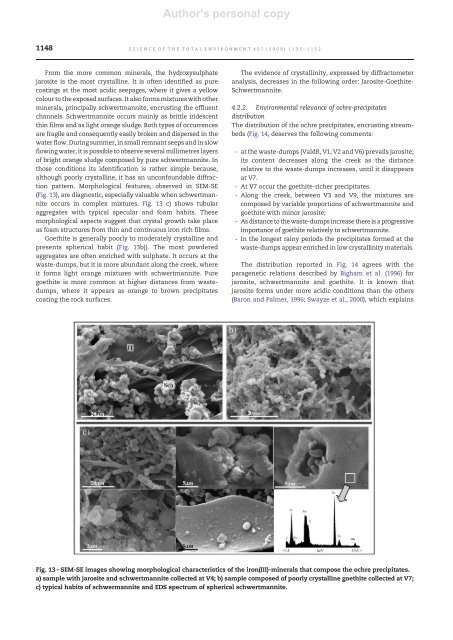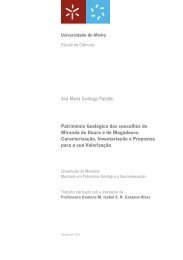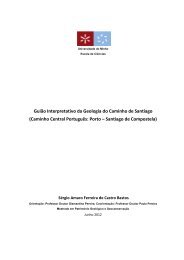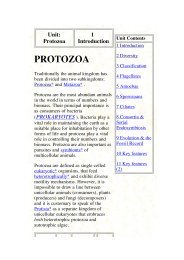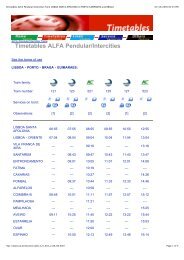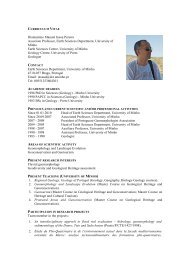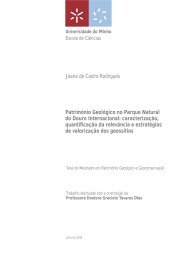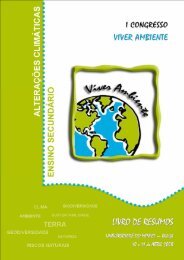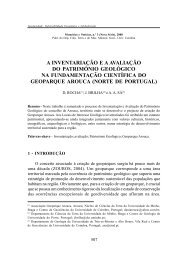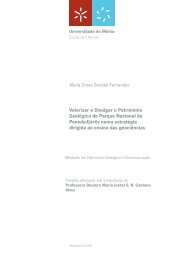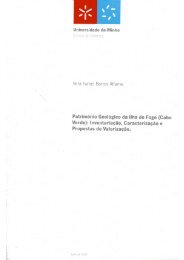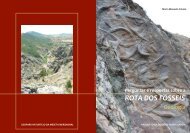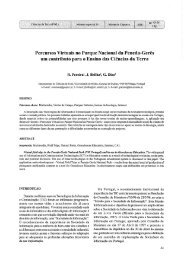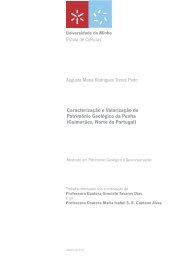Descarregue o Livro do Curso a partir daqui - Departamento de ...
Descarregue o Livro do Curso a partir daqui - Departamento de ...
Descarregue o Livro do Curso a partir daqui - Departamento de ...
You also want an ePaper? Increase the reach of your titles
YUMPU automatically turns print PDFs into web optimized ePapers that Google loves.
Author's personal copy<br />
1148 SCIENCE OF THE TOTAL ENVIRONMENT 407 (2009) 1135– 1152<br />
From the more common minerals, the hydroxysulphate<br />
jarosite is the most crystalline. It is often i<strong>de</strong>ntified as pure<br />
coatings at the most acidic seepages, where it gives a yellow<br />
colour to the exposed surfaces. It also forms mixtures with other<br />
minerals, principally schwertmannite, encrusting the effluent<br />
channels. Schwertmannite occurs mainly as brittle iri<strong>de</strong>scent<br />
thin films and as light orange sludge. Both types of occurrences<br />
are fragile and consequently easily broken and dispersed in the<br />
water flow. During summer, in small remnant seeps and in slow<br />
flowing water, it is possible to observe several millimetres layers<br />
of bright orange sludge composed by pure schwertmannite. In<br />
those conditions its i<strong>de</strong>ntification is rather simple because,<br />
although poorly crystalline, it has an unconfoundable diffraction<br />
pattern. Morphological features, observed in SEM-SE<br />
(Fig. 13), are diagnostic, especially valuable when schwertmannite<br />
occurs in complex mixtures. Fig. 13 c) shows tubular<br />
aggregates with typical specular and foam habits. These<br />
morphological aspects suggest that crystal growth take place<br />
as foam structures from thin and continuous iron rich films.<br />
Goethite is generally poorly to mo<strong>de</strong>rately crystalline and<br />
presents spherical habit (Fig. 13b)). The most pow<strong>de</strong>red<br />
aggregates are often enriched with sulphate. It occurs at the<br />
waste-dumps, but it is more abundant along the creek, where<br />
it forms light orange mixtures with schwertmannite. Pure<br />
goethite is more common at higher distances from wastedumps,<br />
where it appears as orange to brown precipitates<br />
coating the rock surfaces.<br />
The evi<strong>de</strong>nce of crystallinity, expressed by diffractometer<br />
analysis, <strong>de</strong>creases in the following or<strong>de</strong>r: Jarosite-Goethite-<br />
Schwertmannite.<br />
4.2.2. Environmental relevance of ochre-precipitates<br />
distribution<br />
The distribution of the ochre precipitates, encrusting streambeds<br />
(Fig. 14, <strong>de</strong>serves the following comments:<br />
- at the waste-dumps (ValdR, V1, V2 and V6) prevails jarosite;<br />
its content <strong>de</strong>creases along the creek as the distance<br />
relative to the waste-dumps increases, until it disappears<br />
at V7.<br />
- At V7 occur the goethite-richer precipitates.<br />
- Along the creek, between V3 and V9, the mixtures are<br />
composed by variable proportions of schwertmannite and<br />
goethite with minor jarosite;<br />
- As distance to the waste-dumps increase there is a progressive<br />
importance of goethite relatively to schwertmannite.<br />
- In the longest rainy periods the precipitates formed at the<br />
waste-dumps appear enriched in low crystallinity materials.<br />
The distribution reported in Fig. 14 agrees with the<br />
paragenetic relations <strong>de</strong>scribed by Bigham et al. (1996) for<br />
jarosite, schwertmannite and goethite. It is known that<br />
jarosite forms un<strong>de</strong>r more acidic conditions than the others<br />
(Baron and Palmer, 1996; Swayze et al., 2000), which explains<br />
Fig. 13 – SEM-SE images showing morphological characteristics of the iron(III)-minerals that compose the ochre precipitates.<br />
a) sample with jarosite and schwertmannite collected at V4; b) sample composed of poorly crystalline goethite collected at V7;<br />
c) typical habits of schwermannite and EDS spectrum of spherical schwertmannite.


